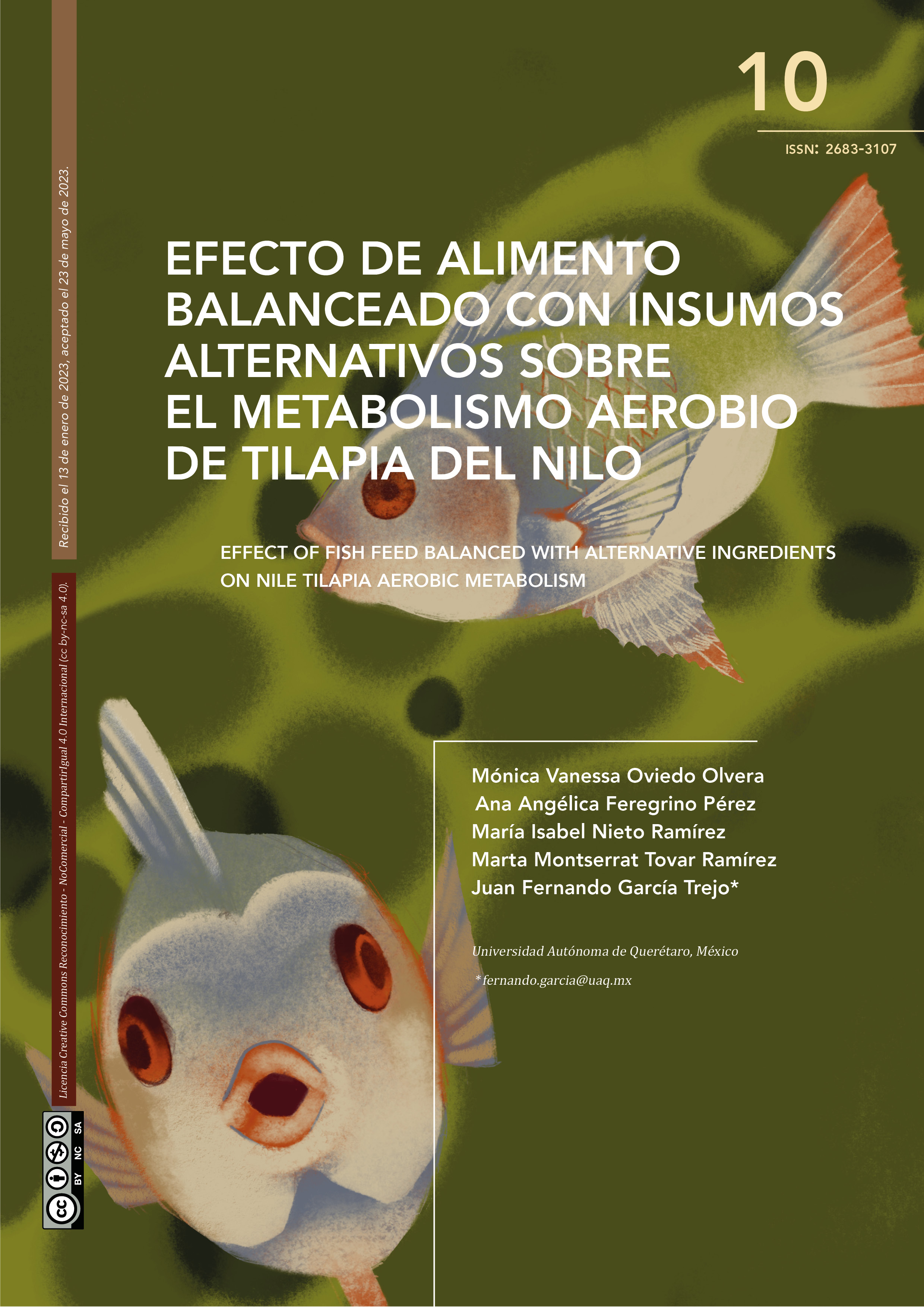Resumen
La acuicultura ha optado por el desarrollo de nuevos alimentos formulados con ingredientes alternativos a la harina de pescado con el fin de mantener su acelerado desarrollo y sustentabilidad. Entre los insumos más relevantes están las microalgas y la larva de mosca soldado negra por su contenido de macro y micronutrientes. El objetivo de este trabajo fue analizar el efecto de un alimento balanceado con estos insumos sobre el metabolismo aerobio de tilapia del Nilo. La inclusión de ambos insumos alternativos disminuyó el consumo de oxígeno en los peces y una menor excreta de amonio, lo que está relacionado con un mejor aprovechamiento de la proteína por el organismo. Asimismo, ambas variables están involucradas en la condición de estrés, por lo que las dietas experimentales también disminuyeron el estrés por cambio de alimentación en las tilapias. Las microalgas y larva de mosca soldado negra resultaron ser insumos alternativos viables para el desarrollo de alimentos acuícolas sin afectar el crecimiento y metabolismo de los peces.
Referencias
FAO, The State of World Fisheries and Aquaculture 2020. 2020.
K. Hua et al., “The Future of Aquatic Protein: Implications for Protein Sources in Aquaculture Diets,” One Earth, vol. 1, no. 3, pp. 316–329, 2019, doi: 10.1016/j.oneear.2019.10.018.
L. Gasco et al., Feeds for the Aquaculture Sector. Springer International Publishing, 2018.
R. Magalhães, A. Sánchez-López, R. S. Leal, S. Martínez-Llorens, A. Oliva-Teles, and H. Peres, “Black soldier fly (Hermetia illucens) pre-pupae meal as a fish meal replacement in diets for European seabass (Dicentrarchus labrax),” Aquaculture, vol. 476, pp. 79–85, 2017, doi: 10.1016/j.aquaculture.2017.04.021.
C. Nasopoulou and I. Zabetakis, “Benefits of fish oil replacement by plant originated oils in compounded fish feeds. A review,” LWT - Food Sci. Technol., vol. 47, no. 2, pp. 217–224, 2012, doi: 10.1016/j.lwt.2012.01.018.
R. Sathasivam, R. Radhakrishnan, A. Hashem, and E. F. Abd_Allah, “Microalgae metabolites: A rich source for food and medicine,” Saudi J. Biol. Sci., vol. 26, no. 4, pp. 709–722, 2019, doi: 10.1016/j.sjbs.2017.11.003.
M. R. Shah et al., “Microalgae in aquafeeds for a sustainable aquaculture industry,” J. Appl. Phycol., vol. 30, no. 1, pp. 197–213, 2018, doi: 10.1007/s10811-017-1234-z.
M. Henry, L. Gasco, G. Piccolo, and E. Fountoulaki, “Review on the use of insects in the diet of farmed fish: Past and future,” Anim. Feed Sci. Technol., vol. 203, no. 1, pp. 1–22, 2015, doi: 10.1016/j.anifeedsci.2015.03.001.
K. Hua, “A meta-analysis of the effects of replacing fish meals with insect meals on growth performance of fish,” Aquaculture, vol. 530, no. May 2020, p. 735732, 2021, doi: 10.1016/j.aquaculture.2020.735732.
P. Mayzaud and R. Conover, “O:N atomic ratio as a tool to describe zooplankton metabolism,” Mar. Ecol. Prog. Ser., vol. 45, pp. 289–302, 1988, doi: 10.3354/meps045289.
M. F. Abdelghany, H. B. El-Sawy, S. A. A. Abd El-hameed, M. K. Khames, H. M. R. Abdel-Latif, and M. A. E. Naiel, “Effects of dietary Nannochloropsis oculata on growth performance, serum biochemical parameters, immune responses, and resistance against Aeromonas veronii challenge in Nile tilapia (Oreochromis niloticus),” Fish Shellfish Immunol., vol. 107, pp. 277–288, 2020, doi: 10.1016/j.fsi.2020.10.015.
H. Muin, N. M. Taufek, M. S. Kamarudin, and S. A. Razak, “Growth performance, feed Utilization and body composition of nile tilapia, Oreochromis niloticus (Linnaeus, 1758) fed with different levels of black soldier fly, Hermetia illucens (Linnaeus, 1758) maggot meal diet,” Iran. J. Fish. Sci., vol. 16, no. 2, pp. 567–577, 2017.
K. Hua, “A meta-analysis od the effects of replacing fish meals with insect meals on growth performance of fish,” Aquaculture, vol. 530, no. 735732, 2021, doi: 10.1016/j.aquaculture.2020.735732
F. J. Fawole, A. A. Adeoye, L. O. Tiamiyu, K. I. Ajala, S. O. Obadara, and I. O. Ganiyu, “Substituting fishmeal with Hermetia illucens in the diets of African catfish (Clarias gariepinus): Effects on growth, nutrient utilization, haemato-physiological response, and oxidative stress biomarker,” Aquaculture, vol. 518, no. December 2019, p. 734849, 2020, doi: 10.1016/j.aquaculture.2019.734849.
S. López-Tejeida, J.F. García-Trejo, L. Félix-Cuencas, J.J. De León-Ramírez, M. Villegas-Villegas and L.B. Flores-Tejeida, “Nitrogen excretion and oxygen consumption on hyper intensive tilapia Oreochromis niloticus culture using three different commercial diets,” Lat. Ame. J. Aqua. Res., vol.48, no. 5, pp. 11, 2020, doi: 0.3856/vol48-issue5-fulltext-2539
Z. Zheng, C. Jin, M. Li, P. Bai, and S. Dong, “Effects of temperature and salinity on oxygen consumption and ammonia excretion of juvenile miiuy croaker, Miichthys miiuy (Basilewsky),” Aquac. Int., vol. 16, no. 6, pp. 581–589, 2008, doi: 10.1007/s10499-008-9169-7.
M. W. Feeley, D. D. Benetti, and J. S. Ault, “Elevated oxygen uptake and high rates of nitrogen excretion in early life stages of the cobia Rachycentron canadum (L.), a fast-growing subtropical fish,” doi: 10.1111/j.1095-8649.2007.01645.x.

Esta obra está bajo una licencia internacional Creative Commons Atribución-NoComercial-CompartirIgual 4.0.
Derechos de autor 2024 Perspectivas de la Ciencia y la Tecnología

